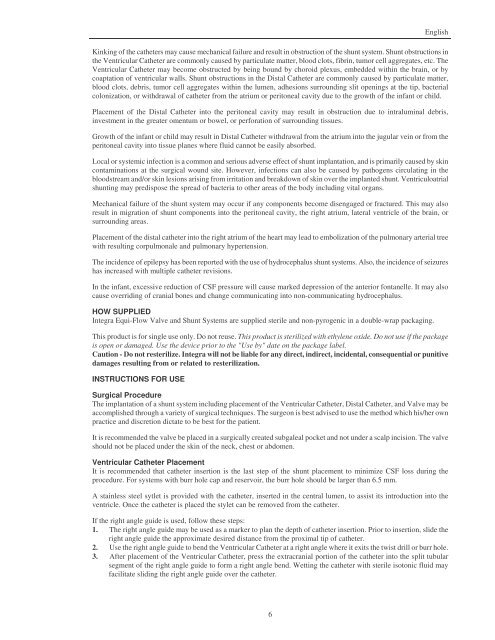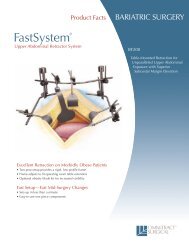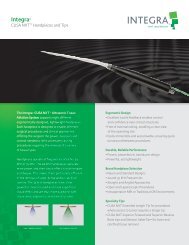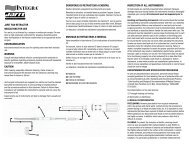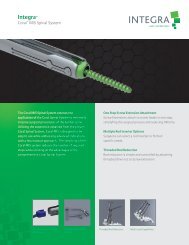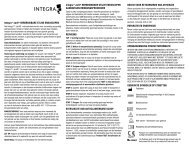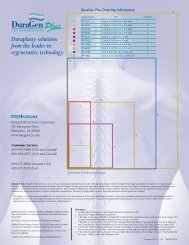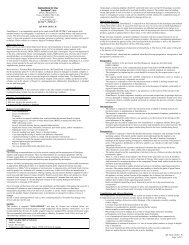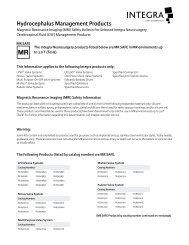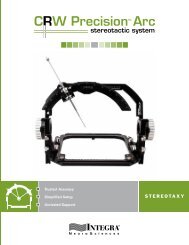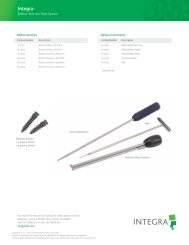Equi-Flow Valve IFU
Equi-Flow Valve IFU
Equi-Flow Valve IFU
Create successful ePaper yourself
Turn your PDF publications into a flip-book with our unique Google optimized e-Paper software.
EnglishKinking of the catheters may cause mechanical failure and result in obstruction of the shunt system. Shunt obstructions inthe Ventricular Catheter are commonly caused by particulate matter, blood clots, fibrin, tumor cell aggregates, etc. TheVentricular Catheter may become obstructed by being bound by choroid plexus, embedded within the brain, or bycoaptation of ventricular walls. Shunt obstructions in the Distal Catheter are commonly caused by particulate matter,blood clots, debris, tumor cell aggregates within the lumen, adhesions surrounding slit openings at the tip, bacterialcolonization, or withdrawal of catheter from the atrium or peritoneal cavity due to the growth of the infant or child.Placement of the Distal Catheter into the peritoneal cavity may result in obstruction due to intraluminal debris,investment in the greater omentum or bowel, or perforation of surrounding tissues.Growth of the infant or child may result in Distal Catheter withdrawal from the atrium into the jugular vein or from theperitoneal cavity into tissue planes where fluid cannot be easily absorbed.Local or systemic infection is a common and serious adverse effect of shunt implantation, and is primarily caused by skincontaminations at the surgical wound site. However, infections can also be caused by pathogens circulating in thebloodstream and/or skin lesions arising from irritation and breakdown of skin over the implanted shunt. Ventriculoatrialshunting may predispose the spread of bacteria to other areas of the body including vital organs.Mechanical failure of the shunt system may occur if any components become disengaged or fractured. This may alsoresult in migration of shunt components into the peritoneal cavity, the right atrium, lateral ventricle of the brain, orsurrounding areas.Placement of the distal catheter into the right atrium of the heart may lead to embolization of the pulmonary arterial treewith resulting corpulmonale and pulmonary hypertension.The incidence of epilepsy has been reported with the use of hydrocephalus shunt systems. Also, the incidence of seizureshas increased with multiple catheter revisions.In the infant, excessive reduction of CSF pressure will cause marked depression of the anterior fontanelle. It may alsocause overriding of cranial bones and change communicating into non-communicating hydrocephalus.HOW SUPPLIEDIntegra <strong>Equi</strong>-<strong>Flow</strong> <strong>Valve</strong> and Shunt Systems are supplied sterile and non-pyrogenic in a double-wrap packaging.This product is for single use only. Do not reuse. This product is sterilized with ethylene oxide. Do not use if the packageis open or damaged. Use the device prior to the "Use by" date on the package label.Caution - Do not resterilize. Integra will not be liable for any direct, indirect, incidental, consequential or punitivedamages resulting from or related to resterilization.INSTRUCTIONS FOR USESurgical ProcedureThe implantation of a shunt system including placement of the Ventricular Catheter, Distal Catheter, and <strong>Valve</strong> may beaccomplished through a variety of surgical techniques. The surgeon is best advised to use the method which his/her ownpractice and discretion dictate to be best for the patient.It is recommended the valve be placed in a surgically created subgaleal pocket and not under a scalp incision. The valveshould not be placed under the skin of the neck, chest or abdomen.Ventricular Catheter PlacementIt is recommended that catheter insertion is the last step of the shunt placement to minimize CSF loss during theprocedure. For systems with burr hole cap and reservoir, the burr hole should be larger than 6.5 mm.A stainless steel sytlet is provided with the catheter, inserted in the central lumen, to assist its introduction into theventricle. Once the catheter is placed the stylet can be removed from the catheter.If the right angle guide is used, follow these steps:1. The right angle guide may be used as a marker to plan the depth of catheter insertion. Prior to insertion, slide theright angle guide the approximate desired distance from the proximal tip of catheter.2. Use the right angle guide to bend the Ventricular Catheter at a right angle where it exits the twist drill or burr hole.3. After placement of the Ventricular Catheter, press the extracranial portion of the catheter into the split tubularsegment of the right angle guide to form a right angle bend. Wetting the catheter with sterile isotonic fluid mayfacilitate sliding the right angle guide over the catheter.6


